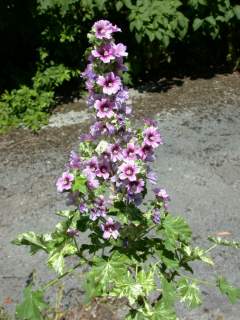 Lavatera
arborea L.,
Lavatera
arborea L.,back to Tree Mallows
back to Digital Herbarium
more images
The Lavatera Pages
 Lavatera
arborea L.,
Lavatera
arborea L.,
![]() Tree
Mallow, Velvet Tree Mallow,
Tree
Mallow, Velvet Tree Mallow,
![]() Baummalve,
Baumförmige Strauchpappel, Strauchmalve
Baummalve,
Baumförmige Strauchpappel, Strauchmalve ![]() jättemalva
jättemalva
![]() Lavatère,
Lavatère arborescente, Mauve royale
Lavatère,
Lavatère arborescente, Mauve royale
![]() Mauve,
eune mauve
Mauve,
eune mauve ![]() Grande
Mauve
Grande
Mauve
![]() Malvone
maggiore, Malva arborea, Malvone, Malva reale
Malvone
maggiore, Malva arborea, Malvone, Malva reale ![]() malva
arbórea, malva gigante
malva
arbórea, malva gigante
![]() malva,
malvera, malva-arbre, malva fogassa, vauma, vaumera
malva,
malvera, malva-arbre, malva fogassa, vauma, vaumera
![]() Slézovec
Slézovec
![]() Drevesasti
grmièasti oslez
Drevesasti
grmièasti oslez
![]() drvolika
stola
drvolika
stola
![]() Hobbejza
tas-sigra
Hobbejza
tas-sigra
![]() lavatero
roka, malvo roka
lavatero
roka, malvo roka
Distribution: garden cultivar. For the distribution of the species seen under Lavatera arborea.
Habitat: gardens.
Identification: As for Lavatera arborea, except that the leaves (especially during the flowering season), epicalyx and calyx are splashed with cream markings, or sometimes completely of that colour.
Source
A plant obtained from a nursery, and seed from the University of Liverpool (Ness) Botanic Gardens seedlist.
Technical Description
Erect annual, biennial or perennial arboriform shrub to 50-200-300 cm, single-stemmed, later branched at top, initiation of development of side shoots following that of flowers, stellate-tomentose on young parts other than corolla. In subsequent years new shoots produced from the upper parts, never from the base. Stems initially green, becoming suffused with red, then olive and finally grey, with distinct leaf and stipule scars; foliage alternate, stipulate and long-petiolate; stipules green, subulate, marcescent, caducuous, ciliate, 2-4 mm long; petioles green, tomentose, approximately equal in length to the lamina; laminae simple, cordate, suborbicular, to 15 cm in diameter, often much smaller, green or splashed with cream (most extensively on leaves produced in late spring and early summer), 5-nerved, shortly 5-lobed, upper leaves more distinctly lobed, dentate, ciliate, tomentose on upper and lower surfaces,; inflorescence indeterminate, a leafy raceme; flowers hermaphrodite, protandrous, involucellate, borne upright, singly, in pairs, or in fasciculate clusters of 3 to 5 in the axils of upper leaves and of leaves of side shoots; pedicel green, deflexed-tomentose, short, to 1 cm; epicalyx spreading, bracteoles 3, symmetrically disposed, broadly ovate, tomentose, ciliate, about 8 mm long at anthesis, fused for about half their length, green, cream or splashed with cream, accrescent and spreading in fruit; calyx reduplicate-valvate in aestivation, sepals 5, shorter than the bracteoles (c. 4 mm), accrescent and connivent in fruit, connate for about half their length, densely pubsescent, ciliate, cream in aestivation, becoming green in fruit; corolla convolute in aestivation, 3 cm across at anthesis, petals 5, spirally arranged, hypogynous, apex sub-emarginate, 15-20 mm long, rose with 5 darker veins, base and claw dark purple; staminal column about 10 mm long, antheriferous in upper half, hispid on lower half, near white extensively streaked with purple; filaments rose-purple, anthers rose(?), reniform, unilocular; pollen white; ovary 8-loculate, locules uniovulate, ovules ascending, placentation axile; style branches filiform, white, as many as the locules, stigmas introrsely decurrent; fruit schizocarpous, verticillate, about 1 cm across; axis about 1.5 mm diameter, conical, somewhat protruding beyond the mericarps, apex acute; mericarps 8, dorsal face tomentose, with irregular broad-V shaped ridges, lateral faces glabrous, irregularly ridged, sometimes fenestrate, angle sharp, somewhat sinuate; the single seed conformed to the cell, which it completely fills; the testa crustaceous, smooth; embryo incurved into an incomplete ring around the scanty soft or mucilaginous albumen, cotyledons broad and foliaceous, somewhat infolded, radicle centripetal-inferior.
Description
|
Lavatera arborea is an erect tree-like perennial, growing to 10 ft in height. The vegetative parts have a covering of stellate hairs. The young stems are green. As they age they developed a reddish tinge, before becoming olive and finally gray. At intermediate ages they bear distinctive leaf and petiole scars. The base of the trunk is bare, side shoots being produced in the upper parts only, leading to the tree-like habit of the plant. |
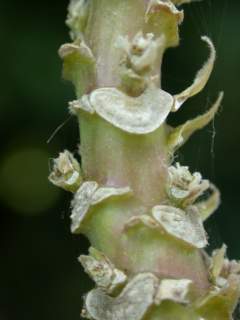 |
|
The leaves are borne alternately (one per node). They are up to 15 cm across, but often much smaller, especially on flowering shoots. They are variously splashed with cream, most prominently on flowering shoots, and are at some times solely green. They are shallowly palmately lobed, with acute apices, heart-shaped bases, and toothed, hair-fringed margins. The stalks are green and tomentose, and approximately as long as the blades. |
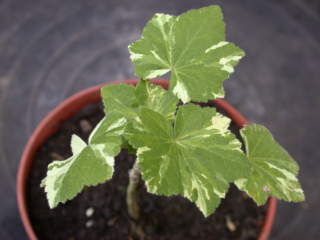
|
|
The stipules are small (up to 4mm long) and roughly triangular in shape |
|
|
The flowers are borne upright, single, in pairs, or most commonly in fasciculate clusters (i.e. lacking a common stalk for the cluster) of 3 to 5 in the leaf axils. They consist of an epicalyx of 3 fused bracteoles, a calyx of 5 sepals, a corolla of 5 petals, an androecium and a gynoecium. |

|
|
The flower stalk (pedicel) is short, about 1 cm long, green in colour, and covered with a dense covering of white hairs pointing back towards the stem. |
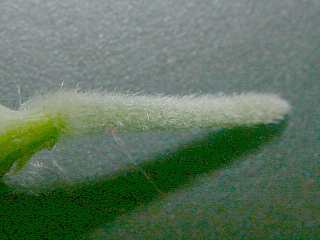 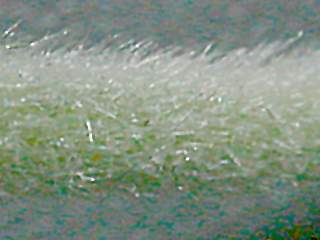 |
|
The epicalyx is composed of 3 bracteoles which are broadly ovate, and fused for about half their length. They are a mixture of green and cream, predominately, sometimes exclusively the latter. They are tomentose and ciliate. |
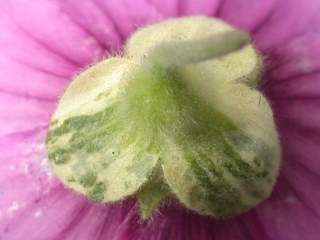 |
|
The sepals are much smaller (c. 4 mm) than the bracteoles, and are almost completely obscured by them in bud and flower. They are triangular in outline, with an acute apex, ciliate margin and densely pubescent surfaces. In fruit they lie flat over the upper surface of the fruit, partially obscuring the fruit. |
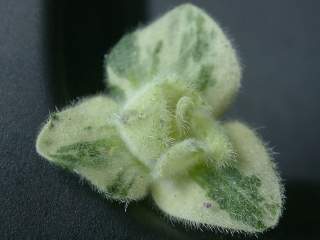 |
|
|
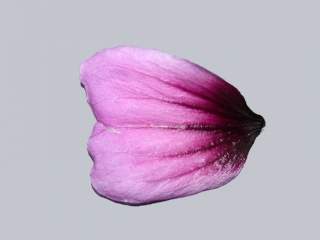 |
|
The staminal column is a little over 1 cm in length. It is white in colour, with purple streaks. The lower half bears white haris. The upper half is antheriferous, the many (c. 40?) filaments being rose-purple in colour, and the pollen white. |
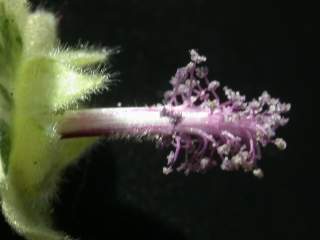 |
|
The style is enclosed by the staminal column and is terminated by 6-8 style branches. These are white, slightly tinged with rose (the colour is exagerrated in the photograph due to reflected colour from the petals), and threadlike. The stigmas are introrsely decurrent. |
 |
|
The fruit is about 1 cm across, surrounded by the spreading bracteoles and partially covered by the sepals. It is composed of 6-8 seed bearing segments disposed in a ring about a conical, pointed, protruding axis. |
|
|
The mericarps are shaped like a segment of an orange. They are about 3mm across in their longest dimension. There is a sharp angle between the lateral and dorsal faces. The lateral faces are flat, and ridged (the ridges being about 1/3rd of the width of the gaps between them), and often bear, towards the axis, a fenestra giving a view of the seed. The dorsal face is weakly ridged and densely covered with short hairs. |
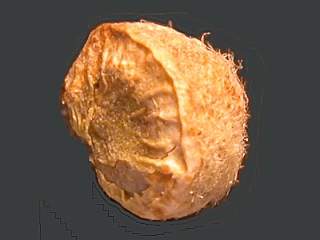 |
Cultivation: Seed may be sown indoors, lightly covered, in mid-spring, for planting out later. Germination is easy and rapid. Sowing in the flowering position may also work, but I don't have experience of this. In my experience plants do not reliably survive their first winter, and it may be preferable to overwinter young plants indoors/under glass. Bean5 says that 'Variegata' must be propagated by cuttings, but I have found that, at least when grown away from the wild type, this variety comes true from seed.
Cytology: Lavatera arborea is reported as having 40 or 44 chromosomes. It seems to me that it is likely that it is an ancient hexaploid with 42 chromosomes (counting chromosomes is difficult, and errors are possible).
Variation: As this cultivar is propagated by seed it is likely that much of the variation of the species is replicated in this cultivar.
Taxonomy:
Lavatera arborea L., Species Plantarum 690 (1753)
Malva dendromorpha M.F.Ray, Novon, 8(3): 292 (1998),
Lavatera arborea, in common with other species from Lavatera section Anthema, is closely related to Malva section Malva, including Malva sylvestris and the weedy mallows. Martin Forbes Ray4 transfers several of these species, including Lavatera arborea, to Malva. The epithet arborea is preempted by Malva arborea St.-Hil., a synonym of Hibiscus pernambucensis (Talipariti "pernambucense"), and Lavatera arborea was renamed as Malva dendromorpha M. F. Ray. This would seem to be the correct name for the species.
Synonymy: for synonymy of the species see Lavatera arborea.
References
Bibliography
Photographs
photographs in the Lavatera Gallery.
back to Tree Mallows
back to Digital Herbarium
more images
The Lavatera Pages
Acknowledgements and Copyright
photographs © 2003, 2004 Stewart Robert Hinsley
text and HTML © 2004 Stewart Robert Hinsley